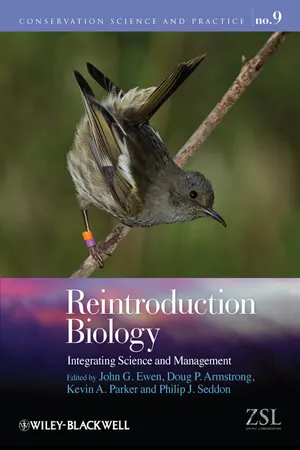
Reintroduction Biology
Integrating Science and Management
- English
- ePUB (mobile friendly)
- Available on iOS & Android
Reintroduction Biology
Integrating Science and Management
About This Book
This book aims to further advance the field of reintroduction biology beyond the considerable progress made since the formation of the IUCN/SSC Re-introduction Specialist Group. Using an issue-based framework that purposely avoids a structure based on case studies the book's central theme is advocating a strategic approach to reintroduction where all actions are guided by explicit theoretical frameworks based on clearly defined objectives. Issues covered include husbandry and intensive management, monitoring, and genetic and health management. Although taxonomically neutral there is a recognised dominance of bird and mammal studies that reflects the published research in this field. The structure and content are designed for use by people wanting to bridge the research-management gap, such as conservation managers wanting to expand their thinking about reintroduction-related decisions, or researchers who seek to make useful applied contributions to reintroduction.
Frequently asked questions
Information
| Analogue species | Closely related form that could be used as an ecological replacement for an extinct species (Parker et al., 2010) |
| Assisted colonization | Translocation of species beyond their natural range to protect them from human-induced threats, such as climate change (Ricciardi & Simberlof, 2009a) |
| Assisted migration | Synonym for assisted colonization |
| Augmentation | Synonym for re-enforcement |
| Benign introduction | Synonym for conservation introduction |
| Biological control | Intentional use of parasitoid, predator, pathogen, antagonist or competitor to suppress a pest population (Hoddle, 2004) |
| Classical biocontrol | The introduction of exotic natural enemies to control exotic pests (Thomas & Willis, 1998) |
| Conservation introduction | An attempt to establish a species, for the purposes of conservation, outside its recorded distribution but within an appropriate habitat and ecogeographical area (IUCN, 1998) |
| Ecological replacement | Conservation introduction of the most suitable extant form to fill the ecological niche left vacant by the extinction of a species (Seddon & Soorae, 1999) |
| Ecological restoration | The process of assisting the recovery of an ecosystem that has been degraded, damaged or destroyed (SER, 2004) |
| Establishment | Survival and successful breeding by founder individuals and their offspring; this is a prerequisite for, but not a guarantee of, population persistence |
| Follow-up translocation | Where one or more additional translocations are conducted to supplement an initial population established by reintroduction (Armstrong & Ewen, 2001) |
| Introduction | Intentional or accidental dispersal by a human agency of a living organism outside its historically known native range (IUCN, 1987) |
| Managed relocation | Synonym for assisted colonization |
| Marooning | Translocation to a predator-free offshore island |
| Persistence | The likelihood of population decline or extinction over some appropriate taxon-specific time frame |
| Re-enforcement | Addition of individuals to an existing population of conspecifics (IUCN, 1998) |
| Re-establishment | Synonym for reintroduction that implies the reintroduction has resulted in establishment (IUCN, 1998) |
| Rehabilitation | The managed process whereby a displaced, sick, injured or orphaned wild animal regains the health and skills it requires to function normally and live self-sufficiently (IWRC, 2009) |
| Reintroduction | Intentional movement of an organism into a part of its native range from which it has disappeared or become extirpated in historic times (IUCN, 1987) |
| Reintroduction biology | Research undertaken to improve the outcomes of reintroductions and other translocations (Armstrong & Seddon, 2008) |
| Relocation | Synonym for translocation |
| Restocking | Synonym for re-enforcement |
| Restoration ecology | The science upon which the practice of ecological restoration is based (SER, 2004) |
| Species restoration | The application of any of a wide range of management tools, including translocation, that aim to improve the conservation status of wild populations |
| Subspecific substitution | A subset of ecological replacement where the replacement taxon is a subspecies (Seddon & Soorae, 1999) |
| Supplementation | Synonym for re-enforcement |
| Translocation | Movement of living organisms from one area with free release in another (IUCN, 1987) |
| Transplantation | Synonym for translocation |

Table of contents
- Cover
- Series Page
- Title Page
- Copyright
- Contributors
- Memorium of Don Merton
- Foreword
- Preface
- Chapter 1: Animal Translocations: What Are They and Why Do We Do Them?
- Chapter 2: A Tale of Two Islands: The Rescue and Recovery of Endemic Birds in New Zealand and Mauritius
- Chapter 3: Selecting Suitable Habitats for Reintroductions: Variation, Change and the Role of Species Distribution Modelling
- Chapter 4: The Theory and Practice of Catching, Holding, Moving and Releasing Animals
- Chapter 5: Dispersal and Habitat Selection: Behavioural and Spatial Constraints for Animal Translocations
- Chapter 6: Modelling Reintroduced Populations: The State of the Art and Future Directions
- Chapter 7: Monitoring for Reintroductions
- Chapter 8: Adaptive Management of Reintroduction
- Chapter 9: Empirical Consideration of Parasites and Health in Reintroduction
- Chapter 10: Methods of Disease Risk Analysis for Reintroduction Programmes
- Chapter 11: The Genetics of Reintroductions: Inbreeding and Genetic Drift
- Chapter 12: Genetic Consequences of Reintroductions and Insights from Population History
- Chapter 13: Managing Genetic Issues in Reintroduction Biology
- Chapter 14: Summary
- Index